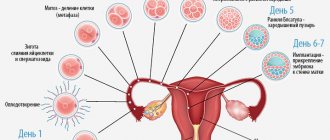Fetal development at 35 weeks of gestation
- All organs and systems of the child are almost fully formed and actively working.
- Very soon the baby will sink lower into the pelvis and mom will begin to breathe much easier.
- The baby’s adrenal glands actively secrete hormones that are responsible for the water-salt and mineral balance in his body.
- You know, but your baby has now grown long nails with which he can accidentally scratch himself.
- The baby's subcutaneous fat continues to accumulate intensively, so that by birth he will be a beautiful and plump baby doll with even and smooth skin and rosy round cheeks.
Usually, by the end of this week, the baby finds the most comfortable position for himself in his mother’s belly, in which he remains until his birth. The most convenient and physiological is cephalic presentation, when the baby's head is located in the lower abdomen.
The fact that your baby is upside down and curled up at 35 weeks of pregnancy does not cause him any discomfort at all.
The baby's movement, height and weight
There is practically no free space left in the mother’s tummy, so at 35 weeks of pregnancy you clearly feel the movements and kicks of your baby. Often such movements can cause pain for a woman. The baby has become strong, so pushing his legs into his mother’s ribs can bring the woman noticeable pain.
The frequency of movements at this stage of pregnancy remains the same. The expectant mother should clearly feel at least 10 kicks and movements of her baby over the course of 12 hours.
Do not forget that an increase in the activity of movements, as well as the absence of movements in the child, requires immediate consultation with a doctor. Such symptoms indicate that the fetus is experiencing discomfort and possible difficulties.
You are now 35 weeks pregnant, the baby weighs on average 2,600 g, and the weight may vary in each individual case. Now the baby is very actively gaining weight, adding about 200 grams weekly. Well, the height of the fetus can already exceed 46 cm.
Features of discharge in pregnant women at 34 weeks
This period is the end of the eighth month of pregnancy.
Mommy is happily awaiting the day of birth, she is actively preparing for the upcoming event, purchasing a dowry, collecting a maternity bag, selecting a maternity hospital, etc.
Therefore, suddenly appearing discharge at 34 weeks of pregnancy can seriously frighten the mother. But unusual sensations and manifestations do not mean the presence of pathology.
The closer the expected due date, the more worried the expectant mother is
Obstetric timing and fetal age
In fact, the 34th week of gestation, according to obstetric calculations, is the ninth month of pregnancy. The fetus is at 32 weeks of development, but judging by the calendar, the pregnant woman is now 7 months and 24 days pregnant. There is nothing left until the birth.
- The baby has grown significantly, and his belly has become almost the maximum size.
- The fetus occupies almost all the available space in it; it has already prepared for its main event - birth, so it is positioned with its head towards the entrance to the uterine cervix.
- Although some women may have options for a different location, for example, across the uterus or butt down.
- It’s too early to judge now, but if the baby does not change position in the coming weeks, the patient will be scheduled for a cesarean section.
- The baby gains a few grams every day; he completes the formation of all vital functions and structures.
- If delivery suddenly begins at exactly this time, then he will be able to survive, but he will need the help of doctors and their supervision in the first weeks.
Now the baby is actively accumulating iron and calcium in order to provide himself with everything necessary during his existence outside the mother’s womb in the first months of life. Therefore, it is important for a woman to eat properly and get proper rest during this period.
Ultrasound diagnostics
You need to do all the necessary tests and checks
Usually by this time the girl has already undergone a third ultrasound examination, which is planned. If there are special indications, such as excluding pathologies or the condition of the fetus, or determining the location of the child, then an ultrasound scan is prescribed unscheduled and additionally.
In addition, ultrasound diagnostics at the thirty-fourth week helps to identify placental pathologies, determine oligohydramnios or insufficiency of amniotic fluid, and also eliminate the possibility of umbilical cord entanglement. These are the most important indicators, on the basis of which the specialist makes a conclusion regarding the stages of delivery, incl.
and choice of method of delivery.
Usually, by this time, mommy has already gained about 10 extra pounds, which invariably affects general organic activity. The likelihood of developing gestosis increases.
If mommy has gained too many kilograms or has excessive swelling, unscheduled diagnostic tests may be needed.
If the presence of protein compounds is detected in the urine, then late toxicosis is diagnosed, in which the patient is admitted to the hospital for preservation.
But there is no need to panic, because not all deviations indicate a problem. Sometimes, according to doctors' estimates, the fetus does not correspond to normal sizes.
This problem is considered one of the most common and is explained by the frequent erroneous calculation of the true gestational age. After all, the obstetric period begins to count from the date of the last menstruation, and true pregnancy begins two or even three weeks later.
If a woman has delayed ovulation, then the period of true pregnancy also shifts, so deviations in fetal parameters occur.
What is your baby like?
Although childbirth can take place at this time, it cannot be called favorable, because the baby still has some time to develop and gain the necessary weight inside the mother’s womb.
Although now the weight of the fetus exceeds 2 kg and 45 cm. The child develops individual facial features that are characteristic only of him.
The original hairs (lanugo) gradually disappear, the baby’s skin becomes light pale, and the cheeks acquire rounded outlines.
- The baby begins to actively train sucking activity, using his finger for this, while swallowing amyloid liquid occurs, which also trains the gastrointestinal structures.
- As a result, renal activity is improved, because about half a liter of urine returns to the amniotic fluid.
- In general, the child will be able to breathe independently upon the onset of labor, but heat retention is not yet developed, so such newborns are placed in an incubator.
- The baby's ears have already separated from the head, and the original lubricant has disappeared from the body.
- The baby is actively stocking up on the necessary microelements, although it is still completely dependent on the mother, because it continues to receive nutrition through the umbilical cord.
- The baby kicks hard because he feels cramped. It is by the movements that the mother will be able to determine the mood of the belly-dweller - he is happy or alarmed.
- Sometimes mommy notices rhythmic twitching of the abdomen, which is associated with the baby’s hiccups. This is not scary, this is how the child trains the respiratory and digestive structures.
- At this stage, experts recommend reading fairy tales to the baby, singing nursery rhymes to him, and talking to him.
If suddenly the movements stop or become too active, then you need to consult a specialist, because such symptoms are accompanied by intrauterine suffering of the fetus. Over a period of 12 hours, the baby should move at least 10 times, and ideally about 2 times within an hour.
At the same time, during the daytime the baby does not move as much, because the mother is busy with daily affairs, but at rest the baby’s motor activity becomes pronounced.
During this period, the pregnant woman is actively developing fetal nervous system structures, and the adjustment between all working systems and organs is actively taking place.
Feelings of a pregnant woman
Expecting twins - double joy in the family
Now mommy’s body has changed dramatically, she has gained weight, and her belly has become noticeably rounder. Therefore, the girl’s feelings became completely different. This is only a temporary discomfort, so you just need to get along with it.
Sensations of movement in the liver and ribs may be especially sensitive. Mothers often complain of pain in this area. In this case, moving to a different position of the body, light rest or a walk can help.
By the way, resting on the left side is much more comfortable than on the right.
Painful sensations in the lumbar area become habitual; they are observed in 2/3 of all pregnant women. The fruit has grown noticeably, so the center of gravity is shifting.
The female body is in complete chaos, it is shaken by hormonal changes, and the joint and ligamentous tissues begin to relax, which is reflected in the walking style and provokes pain symptoms.
To alleviate the condition, a woman is recommended to wear a bandage and choose the most comfortable shoes.
The patient is advised to remove the load from her legs more often by raising them higher. Limb pain is now becoming common as fetal weight continues to increase.
Place your feet on a footrest when sitting, and before going to bed, it is helpful to massage them and take a foot bath with cool water. It is necessary to carefully monitor your condition and internal sensations.
If bloody discharge and painful cramping sensations appear, then you need to urgently call an ambulance and go to the maternity hospital.
Stomach
The girl’s belly has grown noticeably and no longer fits into her usual clothes. Due to the large size of her belly, mommy begins to move extremely carefully. She gets out of bed especially carefully. To prevent stretch marks from forming on the abdomen, it is recommended to lubricate the skin with special anti-stretch mark cosmetics.
During the first pregnancy at this stage, discomfort may occur due to pressure from the fetal head. Sometimes, already at 34 weeks, the baby gradually begins to descend into the pelvic cavity. The baby's head moves closer to the birth canal and begins to put pressure on the pelvic organs. But this is often recorded much later, a couple of weeks before delivery.
Discharge 34 weeks
The presence of certain discharge is typical for any period of gestation. At 34 weeks of pregnancy, discharge is also present and is completely physiological in nature.
- These are ordinary mucous discharges, there are not many of them, they may have a slight milky tint, although most often they are transparent.
- Normally, there should be no odor in the discharge, as well as pathological impurities.
- If the discharge becomes abundant and consists of mucus containing blood lumps, then this may indicate the cervical plug is expelled. This usually happens several weeks or days before delivery.
- If the discharge is watery, has a sweetish odor, and constantly leaks, then you need to undergo a test for amniotic fluid.
- In such a case, delay is dangerous; it is necessary to go to a hospital, where the problem of prolonging pregnancy will be solved.
If there is any defect or damage to the fetal bladder, this can lead to the penetration of an infectious process, which is fraught with certain risks for the fetus and the pregnant woman herself.
Bleeding
Fatigue often increases during pregnancy
Discharges containing large quantities of blood are especially dangerous. Spotting or bloody discharge at 34 weeks of gestation can indicate very dangerous conditions. These symptoms indicate premature delivery or placental abruption.
Placental abruption is dangerous due to the development of fetal hypoxia. Therefore, if bleeding occurs, you should urgently call an ambulance. The patient needs immediate hospitalization to determine the cause of bleeding or to be admitted to the delivery room.
White discharge
The real concern should be a cheesy white discharge that emits a sour odor and causes an itchy sensation in the genitals. Such discharge indicates the development of candidiasis or, popularly, thrush. Treating her is quite problematic, given that the patient is pregnant, and taking antifungal drugs is still contraindicated for her.
Therefore, the woman is prescribed symptomatic therapy. Aimed at relieving unpleasant symptoms such as itching, burning and other discomfort in the genitals. Candidiasis provokes inflammatory lesions of the mucous tissues, which leads to additional traumatic injuries during childbirth.
Sensations and physiological changes in the body of the expectant mother
- It is becoming increasingly difficult for a woman to bear her child. You get tired quickly when walking, so try to walk close to your home.
- By the way, daily walks in the air are very important, because your baby vitally needs oxygen.
- Sometimes severe shortness of breath occurs. If you find it very difficult to breathe, do a simple exercise: you need to get on all fours and inhale and exhale deeply and slowly several times.
- Sex at 35 weeks of pregnancy is contraindicated and should be postponed until better times. Now your body is preparing for the upcoming birth and it is necessary to exclude the possibility of infection in the birth canal.
- It becomes more difficult to sleep. If you experience frequent urination at night, try to avoid drinking large amounts of liquid at night.
If you didn't take a belly photo at this stage of pregnancy, now is the time to catch up. Such a picture, together with a photo of the fetus taken at 35 weeks of pregnancy, will bring a lot of positive emotions to you and your family!
Many women worry when their stomach becomes stone at 35 weeks of pregnancy. Don’t be alarmed, almost all expectant mothers experience a hard stone belly before giving birth, which quickly passes. This may be caused by uterine hypertonicity or training contractions. By the way, the stone heaviness of the lower abdomen can also become a harbinger of the onset of labor, and then the time comes for the woman to go to the maternity hospital.
The appearance of painful sensations in the back, lumbar region and legs is provoked by a serious load caused by an increase in your weight, and even a strong shift in the center of gravity due to an enlarged abdomen. Don't forget to wear a prenatal bandage, avoid standing for long periods of time, unload your back more often and change your body position.
You may also experience headaches. To eliminate them, you need to lie down in a dark, ventilated room and rest. For severe headaches, a cool compress and head massage will help. You need to fall asleep not on your back, but on your side. Additional pillows will help you find the most comfortable sleeping position.
Feelings of a pregnant woman
An ultrasound is often prescribed in the ninth month.
In the 3rd trimester, active preparation for the final reproductive stage is carried out. The uterus is at its peak height. Because of this, pressure occurs on the internal organs, and pain is felt in the stomach area. A growing baby puts pressure on the lungs. Sometimes a pregnant woman feels like she can’t breathe; any physical activity is accompanied by severe shortness of breath. There is no need to be afraid of this. When the month is “closed”, the stomach will begin to sink: breathing will become easier, but additional discomfort will appear in the pelvic area. The lady in this “interesting” position has yet to find out about this.
At the 35th week, disturbances in intestinal motility are observed. Hence the constipation that regularly torments women. The urge to urinate becomes more frequent: the bladder is under pressure. Frequent trips to the toilet disturb night sleep, but even if they weren’t there, it’s already difficult to sleep due to a rounded belly.
Finding a comfortable position is not so easy, especially since the choice is small - only on the side. Sleeping on your back during pregnancy is not recommended, especially in the later stages. And all because of the pressure on the vena cava: this position is dangerous because the fetus will feel a lack of oxygen, which is why its heartbeat slows down. Clamping of the vena cava is also dangerous for a pregnant woman: breathing is impaired and dizziness occurs. If you sleep on your back, there is additional stress on the spine, and the amniotic sac puts maximum pressure on the urinary organs and intestines.
From now on, insomnia becomes a frequent companion. The reason lies not only in the discomfort that appears against the backdrop of an enlarged belly. The long-awaited meeting is approaching, naturally, there are worries about how it will go, whether everything is okay with the baby. There is now little space in the uterus, so the kicks are not as strong. But the baby develops his own “daily routine,” which the mother will undoubtedly feel. When a pregnant woman walks, he rocks and sleeps, and when he tries to sleep, active actions begin.
Is there a danger if my stomach hurts?
Now you need to be very careful about abdominal pain, because normally there should not be any at this time.
If you have a stomach ache at 35 weeks of pregnancy, and the nagging pain radiates to the lower back, you can talk about the likely approach of labor.
Training irregular Braxton-Higgs contractions are already familiar to the mother and quite noticeable. Monitor their intensity, and if they become periodic and are accompanied by increasing abdominal pain, and in addition there is an outpouring of amniotic fluid, you should rush to the maternity hospital.
One of the harbingers of childbirth is a drooping belly in the expectant mother. Abdominal prolapse usually occurs between 36 and 38 weeks. And sometimes the stomach does not drop until the end of the term. If your belly drops at 35 weeks of pregnancy, this does not mean that labor will begin in the next few hours. The beginning of the birth of a baby after the mother’s abdomen subsides may occur in a couple of weeks.
What discharge indicates a threat to the health of the woman and fetus?
By this stage of pregnancy, the nature of vaginal discharge changes slightly. When the thirty-fifth week of pregnancy begins, mucus may be present in the discharge. They are part of the mucus plug that closes the cervix until the end of pregnancy, and thus protects the baby from the penetration of pathogenic microorganisms.
The appearance in a woman of uncharacteristic greenish, yellow, curdled, foamy discharge, mixed with flakes and a strong unpleasant odor, indicates the development of a genital infectious disease, which is often accompanied by swelling, burning and itching in the genital area. In this case, you should rush to see a doctor, who will prescribe mandatory treatment for the infection. Only by treating the disease can you prevent the threat of intrauterine infection of your child!
The appearance of even a small amount of blood in the discharge may indicate a high risk of developing such a complex pathology as placental abruption. In any case, the appearance of blood in vaginal discharge is an unfavorable symptom. A pregnant woman should lie down in bed and call an ambulance.
The rupture of amniotic fluid, or the appearance of liquid yellowish copious discharge, is a signal that labor will begin in the next few hours. Sometimes water pours out in parallel with ongoing contractions. Therefore, do not hesitate to call an ambulance!
Please note that amniotic fluid may leak in portions, which indicates a violation of the membranes. In this case, it is important to see a doctor as soon as possible, since a violation of the integrity of the membranes can cause infection to enter the baby.
Greenish discharge
This is a sign of a bacterial infection. They may bubble or look like a thick dough, but in any case this is an alarming symptom. Often the discharge is accompanied by an unpleasant odor. To determine the cause, the doctor must take a smear for analysis. This is an alarming symptom, so do not put off your visit to the doctor. This phenomenon is typical for a number of problems:
- these are inflammations of the genitourinary system (fallopian tubes, appendages, vagina or cervix);
- sexually transmitted diseases;
- bacterial infections;
- microflora disorders.
Only by knowing exactly the nature of the phenomenon can we give recommendations regarding treatment, so we will not stop and consider what other options there may be.
Childbirth at the thirty-fifth week of pregnancy
The time for childbirth has not yet come, despite the fact that your baby is already quite strong and all the systems of his body are actively working. The expectant mother still needs to carry the baby to ensure its further normal development.
True, some babies can’t wait to be born by the 35th week of pregnancy, and they persistently begin to tell their mothers about this. There is no need to worry too much if the birth occurs this week. Your child will not only survive, but will continue to be absolutely no inferior in development to children born on time.
By this time, the child can breathe independently, and his organs and systems are fully formed. Sometimes additional support for the newborn with the help of life support devices may be required, but this need is already determined by the doctor.
Vaginosis
This is a non-inflammatory disease, which is characterized by changes in the microflora of the vagina, the death of lactoflora and the colonization of the mucous membrane by anaerobic microorganisms.
View gallery
This disease can develop during pregnancy and lead to complications during childbirth. At the same time, it is quite difficult to diagnose, since there are no clear symptoms. The nature of the discharge remains virtually unchanged, but it takes on the smell of rotten fish. If you are sensitive to such nuances, then catch the changes at the very beginning and consult a doctor in time.
Is it necessary to do an ultrasound?
You are now 35 weeks pregnant. An ultrasound at this stage will help determine how the placenta copes with its functions and what is the degree of its maturity, exclude the breech and breech presentation of the child, determine the correspondence of the size of the fetus to the gestational age, and notice in time the danger of entanglement of the umbilical cord.
When performing an ultrasound, attention is paid to the amount and nature of amniotic fluid, which makes it possible to exclude polyhydramnios and oligohydramnios during pregnancy at 35 weeks.
An ultrasound examination will definitely show all possible pathologies and anomalies in the development of your child, if any.
And you also have the opportunity to ask the doctor to take an ultrasound photo of your baby as a souvenir at 35 weeks of pregnancy!
Genital herpes
This is another reason for the appearance of heavy discharge. During pregnancy, the immune system weakens, which means that this disease has every chance to manifest itself. In addition to heavy discharge, symptoms of herpes include a rash and sores on the genitals, as well as itching and burning. There is a high probability of infection of the fetus. If the disease is detected at a late stage, delivery by caesarean section will most likely be offered.
View gallery











